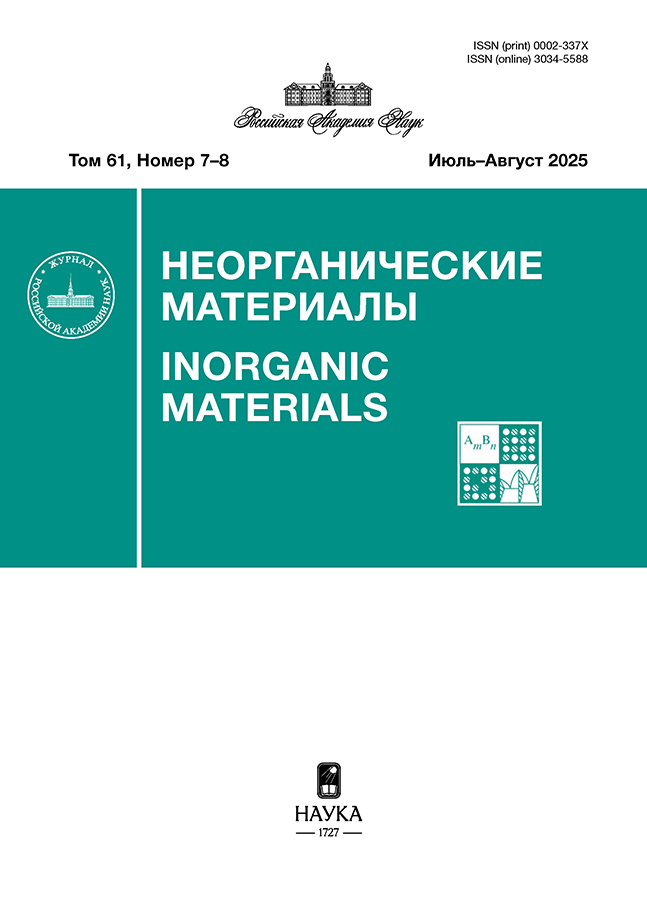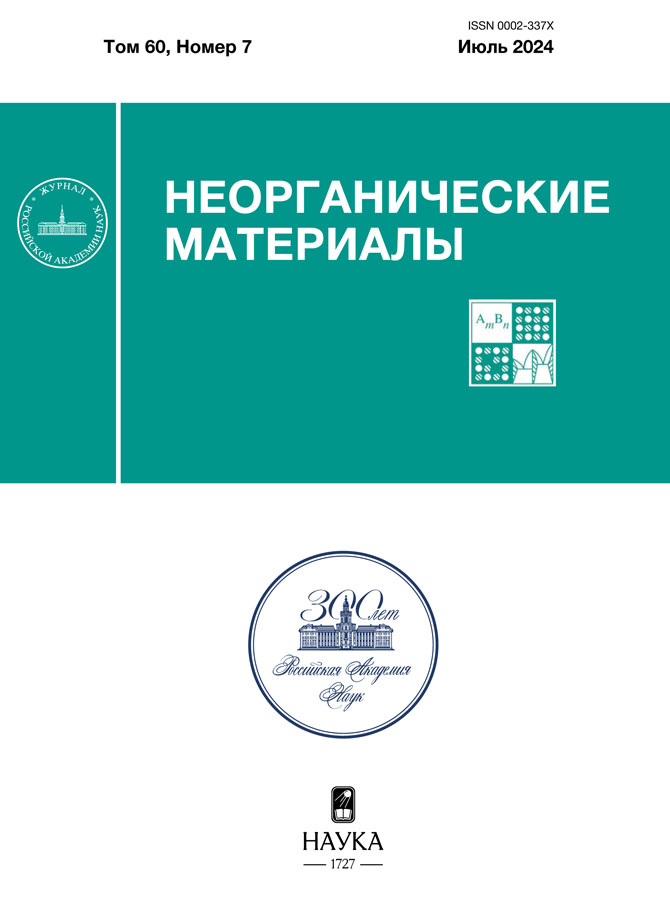Структура, жаростойкость, коррозионная и трибологическая характеристики покрытий, приготовленных электроискровым осаждением порошков Ni и Al на сталь 35
- Авторы: Бурков А.А.1, Кулик М.А.1
-
Учреждения:
- Институт материаловедения Дальневосточного отделения Российской академии наук
- Выпуск: Том 60, № 7 (2024)
- Страницы: 833-845
- Раздел: Статьи
- URL: https://ter-arkhiv.ru/0002-337X/article/view/679367
- DOI: https://doi.org/10.31857/S0002337X24070075
- EDN: https://elibrary.ru/LQWXJB
- ID: 679367
Цитировать
Полный текст
Аннотация
Впервые порошки никеля и алюминия осаждались методом электроискрового легирования на сталь 35. Изучено влияние соотношения порошков Ni и Al в анодной смеси на структуру покрытий, жаростойкость, коррозионное поведение, а также на коэффициент трения и изнашиваемость. Показано, что при повышении концентрации алюминиевого порошка в анодной смеси от 30 до 70 ат. % средняя концентрация алюминия в покрытиях монотонно возрастала с 39 до 63 ат. %, а никеля – снижалась с 46 до 26 ат. %. Установлено, что применение приготовленных покрытий позволяет повысить жаростойкость изделий из стали 35 при температуре 700°С от 13 до 34 раз. Показано, что наиболее твердым, износостойким и жаростойким является покрытие с самым высоким содержанием алюминия.
Ключевые слова
Полный текст
Об авторах
А. А. Бурков
Институт материаловедения Дальневосточного отделения Российской академии наук
Email: marijka80@mail.ru
Россия, ул. Тихоокеанская, 153, Хабаровск, 680042
М. А. Кулик
Институт материаловедения Дальневосточного отделения Российской академии наук
Автор, ответственный за переписку.
Email: marijka80@mail.ru
Россия, ул. Тихоокеанская, 153, Хабаровск, 680042
Список литературы
- Колачев Б.А., Елагин В.И., Ливанов В.А. Металловедение и термическая обработка цветных металлов и сплавов. М: МИСиС, 1999. 413 с.
- Sierra C., Vazquez A.J. NiAl Coating on Carbon Steel with an Intermediate Ni Gradient Layer // Surf. Coat. Technol. 2006. V. 200. № 14–15. P. 4383–4388. https://doi.org/10.1016/j.surfcoat.2005.02.176
- Zhou L., Mehta A., Cho K., Sohn Y. Composition-dependent Interdiffusion Coefficient, Reduced Elastic Modulus and Hardness in γ-, γ′-and β-Phases in the Ni–Al System // J. Alloys Compd. 2017. V. 727. P. 153–162. https://doi.org/10.1016/j.jallcom.2017.07.256
- Shah L.H., Gerlich A., Zhou Y. Design Guideline for Intermetallic Compound Mitigation in Al–Mg Dissimilar Welding through Addition of Interlayer // Int. J. Adv. Manuf. Technol. 2018. V. 94. P. 2667–2678. https://doi.org/10.1007/s00170-017-1038-y
- Konieczny M., Mola R., Thomas P., Kopciał M. Processing, Microstructure and Properties of Laminated Ni-intermetallic Composites Synthesised Using Ni Sheets and Al Foils // Arch. Metall. Mater. 2011. V. 56. №. 3. P. 693–702. https://doi.org/10.2478/v10172-011-0076-y
- Mohammadnezhad M., Shamanian M., Enayati M.H. Formation of Nanostructured Ni–Al Coating on Carbon Steel by Using Mechanical Alloying // Appl. Surf. Sci. 2012. V. 263. P. 730–736. https://doi.org/10.1016/j.apsusc.2012.09.151
- Zadorozhnyy V., Kaloshkin S., Kaevitser E., Romankov S. Coating of Metals with Intermetallics by Mechanical Alloying // J. Alloys Compd. 2011. V. 509. P. S507-S509. https://doi.org/10.1016/j.jallcom.2011.01
- Wu Q., Li S., Ma Y., Gong S. Study on Behavior of Ni–Al Coating with Different Ni/Al Ratios // Vacuum. 2013. V. 93. P. 37–44. https://doi.org/10.1016/j.vacuum.2013.01.001
- Wu C.C., Wu F.B. Microstructure and Mechanical Properties of Magnetron Co-sputtered Ni–Al Coatings // Surf. Coat. Technol. 2009. V. 204. № 6–7. P. 854–859. https://doi.org/10.1016/j.surfcoat.2009.09.019
- Yu Y., Zhou J., Ren S., Wang L., Xin B., Cao S. Tribological Properties of Laser Cladding NiAl Intermetallic Compound Coatings at Elevated Temperatures // Tribol. Int. 2016. V. 104. P. 321–327. https://doi.org/10.1016/j.triboint.2016.09.014
- Brunetti C., Belotti L.P., Miyoshi M.H., Pintaúde G., D’Oliveira A.S.C.M. Influence of Fe on the Room and High-temperature Sliding wear of Ni–Al Coatings // Surf. Coat. Technol. 2014. V. 258. P. 160–167. https://doi.org/10.1016/j.surfcoat.2014.09.036
- Бурков А.А., Кулик М.А., Быцура А.Ю. Структура и свойства Al–Ni–Fe-покрытий на стали 35, полученных методом электроискрового легирования // Металловедение и термическая обработка металлов. 2024. № 7. С. 22–30.
- Burkov A.A., Bytsura A.Y. Influence of Substrate Surface Quality on Electro-Spark Alloying // Surf. Eng. Appl. Electrochem. 2024. V. 60. № 2. P. 204–210. https://doi.org/10.52577/eom.2023.59.6.18
- Бурков А.А., Коневцов Л.А., Крутикова В.О. Влияние длительности разрядов на характеристики покрытий из металлического стекла FeCrWMoCB // Неорган. материалы. 2023. Т. 59. № 7. С. 740–749. https://doi.org/10.31857/S0002337X23070011
- Бурков А.А., Кулик М.А. Электроискровое осаждение покрытий Fe–Cr–Cu на сталь Ст3 // Изв. вузов. Порошковая металлургия и функциональные покрытия. 2023. Т. 17. № 4. С. 51–58. https://doi.org/10.17073/1997-308X-2023-4-51-58
- Химухин С.Н., Гончаров А.В., Ри Э.Х., Хосен Р., Кисломед И.Д. Исследование диффузии никеля из покрытия в сталь // Информационные технологии XXI века. 2016. С. 194–197.
- Бурков А.А., Кулик М.А. Электроискровое осаждение покрытий с использованием порошка Cr3C2 и их характеристика // Письма о материалах. 2019. Т. 9. № 2. С. 243–248. https://doi.org/10.22226/2410-3535-2019-2-243-248
- Emelyanenko A.M., Boinovich L.B. Analysis of Wetting as an Efficient Method for Studying the Characteristics of Coatings and Surfaces and the Processes that Occur on Them: A Review // Inorg. Mater. 2011. V. 47. № 15. P 1667–1675. https://doi.org/10.1134/S0020168511150064
- Верхотуров А.Д. Формирование поверхностного слоя металлов при электроискровом легировании. Владивосток: Дальнаука, 1995. 282 с.
- Radek N., Bartkowiak K. Laser Treatment of Cu–Mo Electro-spark Deposited Coatings // Phys. Procedia. 2011. V. 12. P. 499–505. https://doi.org/10.1016/j.phpro.2011.03.061
- Бурков А.А., Крутикова В.О., Быцура А.Ю., Хе В.К. Ti-Cr-Cu электроискровые покрытия на стали Ст3 // Проблемы черной металлургии и материаловедения. 2023. № 1. С. 93–104. https://doi.org/10.54826/19979258_2023_1_93
- Li Y.C., Zhang W.W., Wang Y., Zhang X.Y., Sun L.L. Effect of Spray Powder Particle Size on the Bionic Hydrophobic Structures and Corrosion Performance of Fe-Based Amorphous Metallic Coatings // Surf. Coat. Technol. 2022. V. 437. P. 128377.
- Bolelli G., Bonferroni B., Laurila J., Lusvarghi L., Milanti A., Niemi K., Vuoristo P. Micromechanical Properties and Sliding Wear Behaviour of HVOF-Sprayed Fe-Based Alloy Coatings // Wear. 2012. V. 276. P. 29–47. https://doi.org/10.1016/j.wear.2011.12.001
- Samadi N., Jamshidi Aval H. Formation of Nickel Aluminide In Situ via Dual-Wire Arc Cladding // Metallograph. Microstruct. Anal. 2024. P. 1–13.
- Archard J.F. Contact and Rubbing of Flat Surfaces // J. Appl. Phys. 1953. V. 24. № 8. P. 981–988.
- Bafandeh M.R., Omidi A., Irankhah A. In Situ Coating of Low Carbon Steel with NiAlFe Powder Mixture via Mechanical Alloying // Surf. Coat. Technol. 2017. V. 315. P. 268–273. https://doi.org/10.1016/j.surfcoat.2017.02.046
- Rosalbino F., Scavino G. Corrosion Behaviour Assessment of Cast and HIPed Stellite 6 Alloy in a Chloride-containing Environment // Electrochim. Аcta. 2013. V. 111. P. 656–662. https://doi.org/10.1016/j.electacta.2013.08.019
- Ding Y., Kong L., Lei W., Li Q., Ding K., He Y. Study on the Technology of Surface Strengthening Ti–6Al–4V Alloy by Near-dry Multi-flow Channel Electrode Electrical Discharge Machining // J. Mater. Res. Technol. 2024. V. 28. P. 2219–2234. https://doi.org/10.1016/j.jmrt.2023.12.133
- Moskalewicz T., Warcaba M., Zimowski S., Łukaszczyk A. Improvement of the Ti–6Al–4V Alloy’s Tribological Properties and Electrochemical Corrosion Resistance by Nanocomposite TiN/PEEK708 Coatings // Metall. Mater. Trans. A. 2019. V. 50. P. 5914–5924. https://doi.org/10.1007/s11661-019-05484-7
- Kim K.H., Lee S.H., Nam N.D., Kim J.G. Effect of Cobalt on the Corrosion Resistance of Low Alloy Steel in Sulfuric acid Solution // Corros. Sci. 2011. V. 53. № 11. P. 3576–3587. https://doi.org/10.1016/j.corsci.2011.07.001
- Guo S., Lu Y., Wu S., Liu L., He M., Zhao C., Lin J. Preliminary Study on the Corrosion Resistance, Antibacterial Activity and Cytotoxicity of Selective-Laser-Melted Ti6Al4V – xCu Alloys // Mater. Sci. Eng. C. 2017. V. 72. Р. 631–640. https://doi.org/10.1016/j.msec.2016.11.126
- Бурков А.А. Получение аморфных покрытий электроискровой обработкой стали 35 в смеси железных гранул с CrMoWCBSi порошком // Обработка металлов: технология, оборудование, инструменты. 2019. Т. 21. № 4. С. 19–30. https://doi.org/10.17212/1994-6309-2019-21.4-19-30
Дополнительные файлы





















